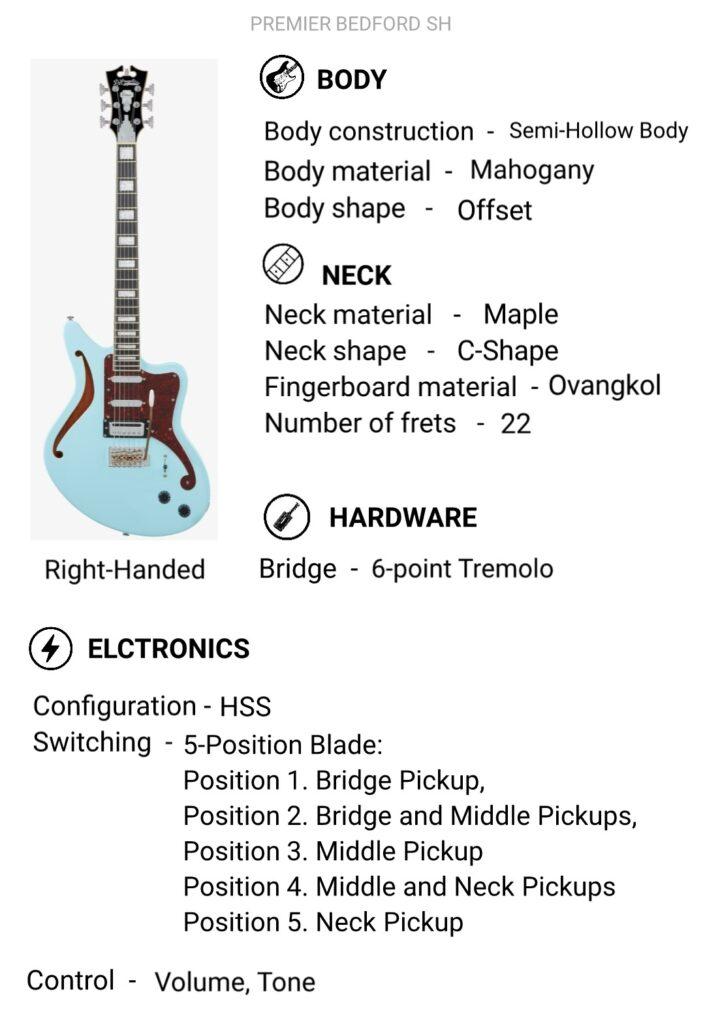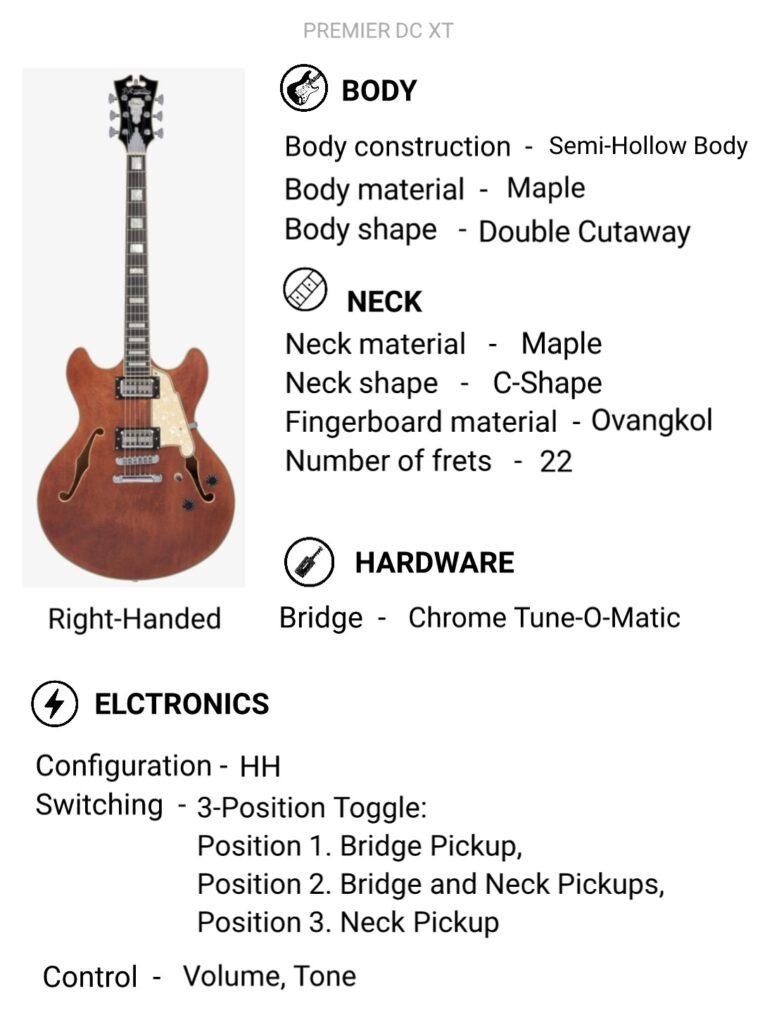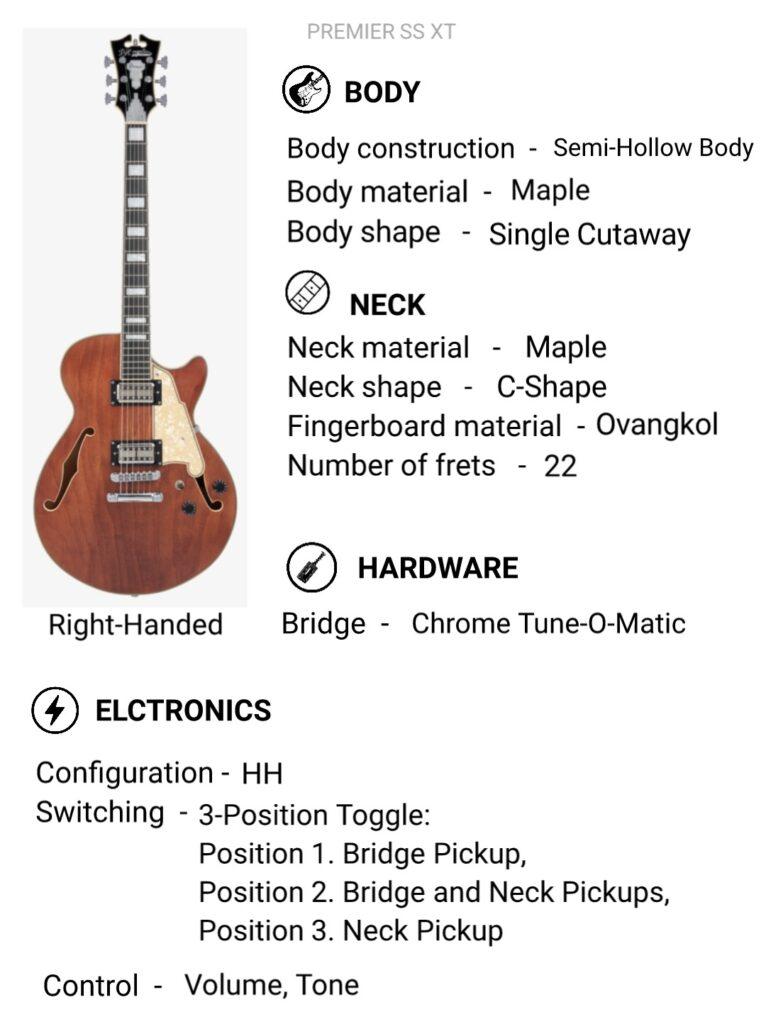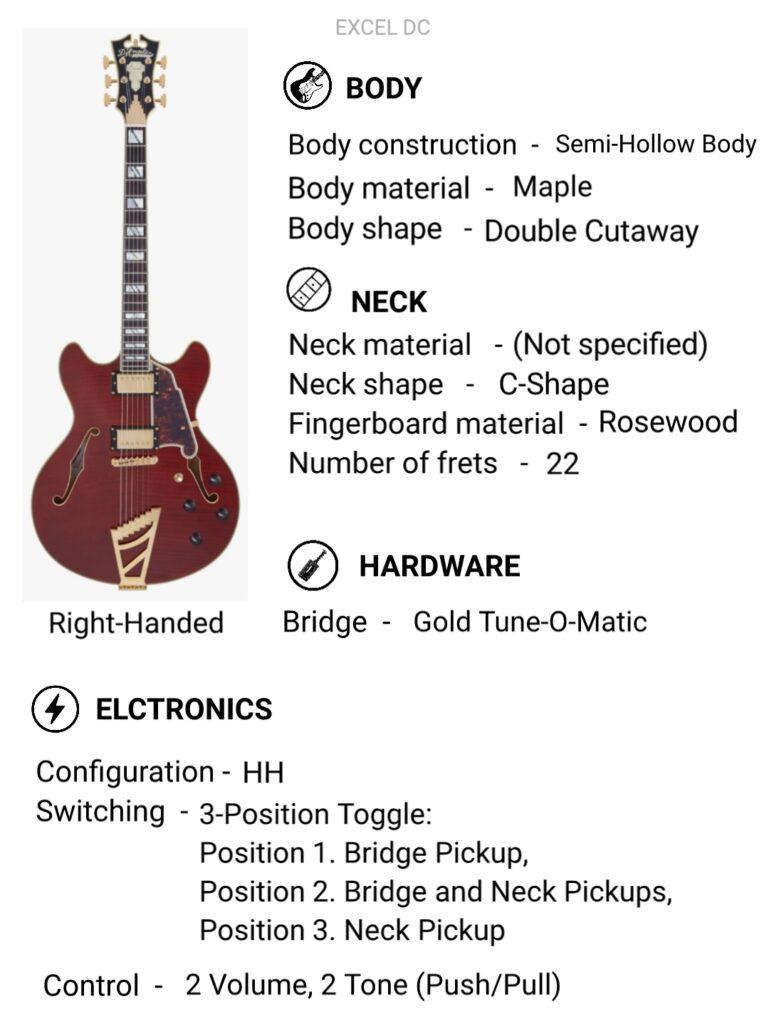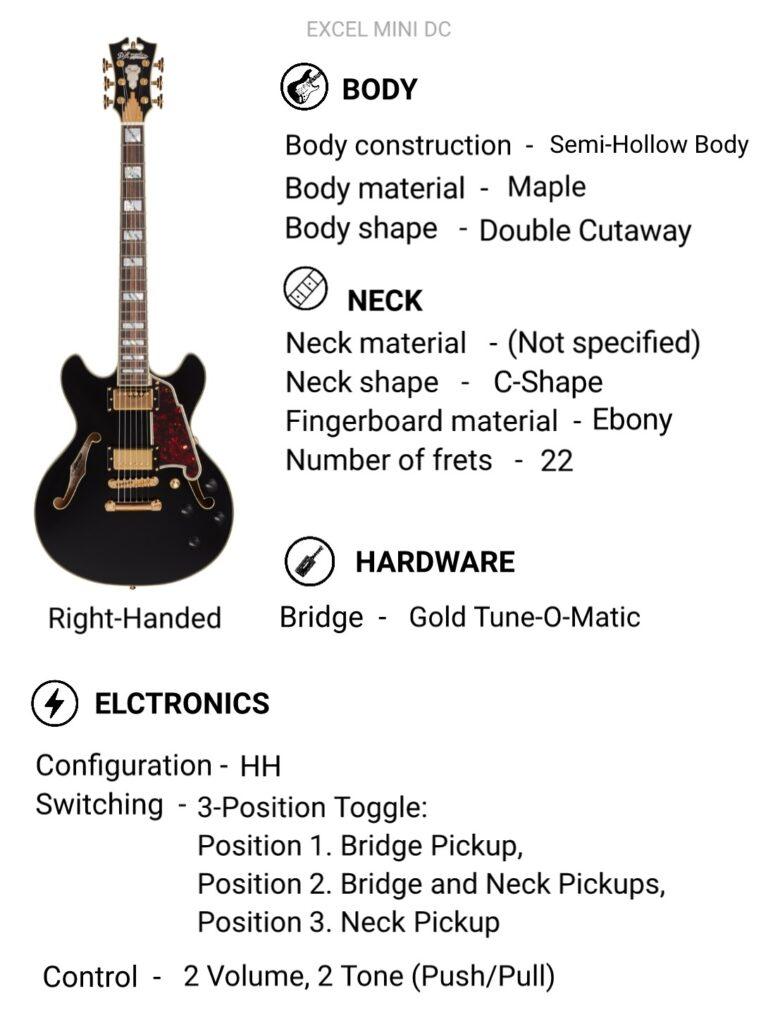Best Semi-hollow body electric guitars with prices, specifications and features from difference online stores at infinicisum.net
PRS CE 24 Semi-Hollow
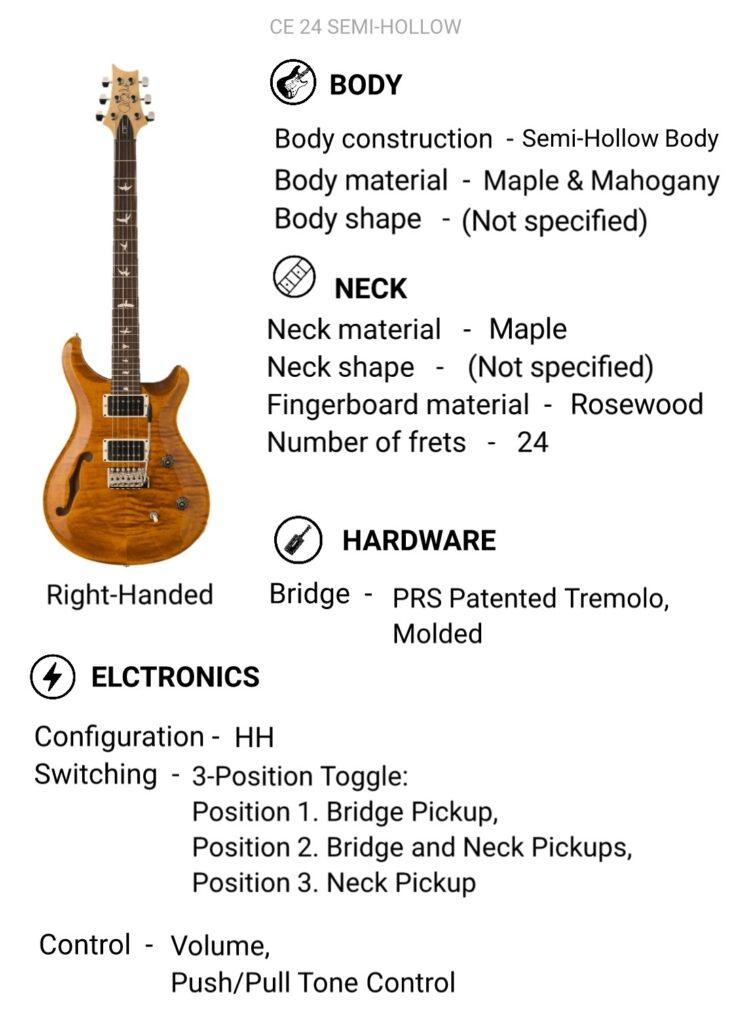
PRS SE Custom 22 Semi-Hollow
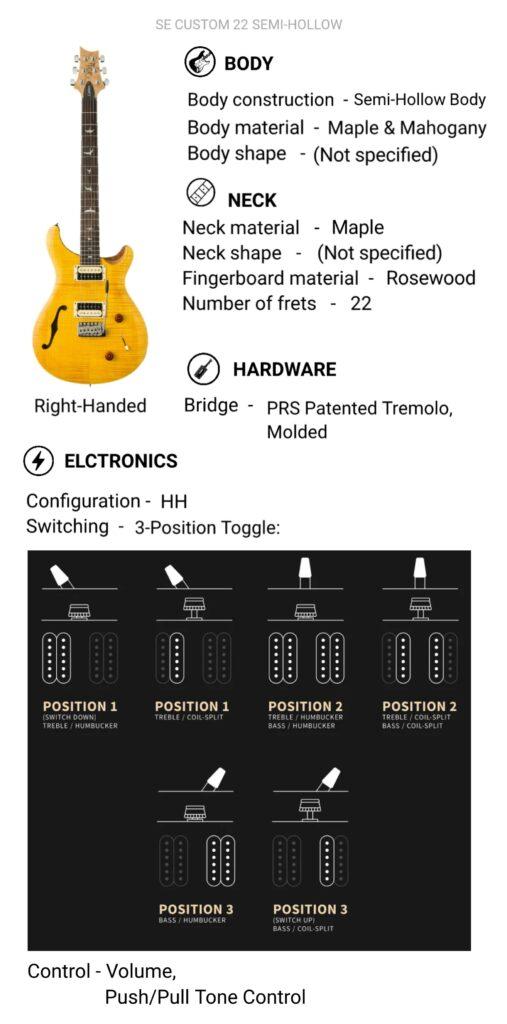
Schecter Corsair

Read More
 Amazon.in
Amazon.in  ₹ 1,28,377
₹ 1,28,377  Go To Store
Go To Store
 Amazon.in
Amazon.in  ₹ 1,28,377
₹ 1,28,377  Go To Store
Go To Store
 Amazon.com
Amazon.com  $ 1552
$ 1552  Go To Store
Go To Store
 Amazon.com
Amazon.com  $ 1552
$ 1552  Go To Store
Go To Store
 Guitar Center
Guitar Center  $ 1,299
$ 1,299  Go To Store
Go To Store
 Guitar Center
Guitar Center  $ 1,299
$ 1,299  Go To Store
Go To Store
Gretsch G2622 Streamliner Center Block Double-Cut With V-Stoptail
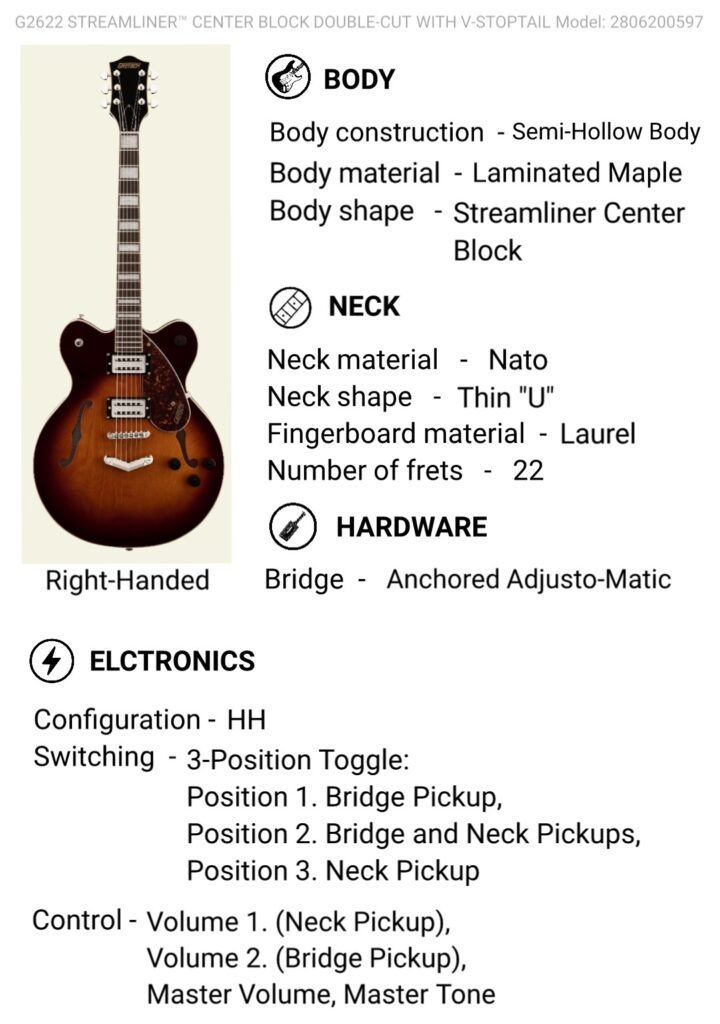
Read More
 Amazon.in
Amazon.in  ₹ 28,024
₹ 28,024  Go To Store
Go To Store
 Amazon.in
Amazon.in  ₹ 28,024
₹ 28,024  Go To Store
Go To Store
 Amazon.com
Amazon.com  $ 339
$ 339  Go To Store
Go To Store
 Amazon.com
Amazon.com  $ 339
$ 339  Go To Store
Go To Store
 Guitar Center
Guitar Center  $ 329
$ 329  Go To Store
Go To Store
Gretsch G2655T Streamliner Center Block Jr. Double-Cut With Bigsby
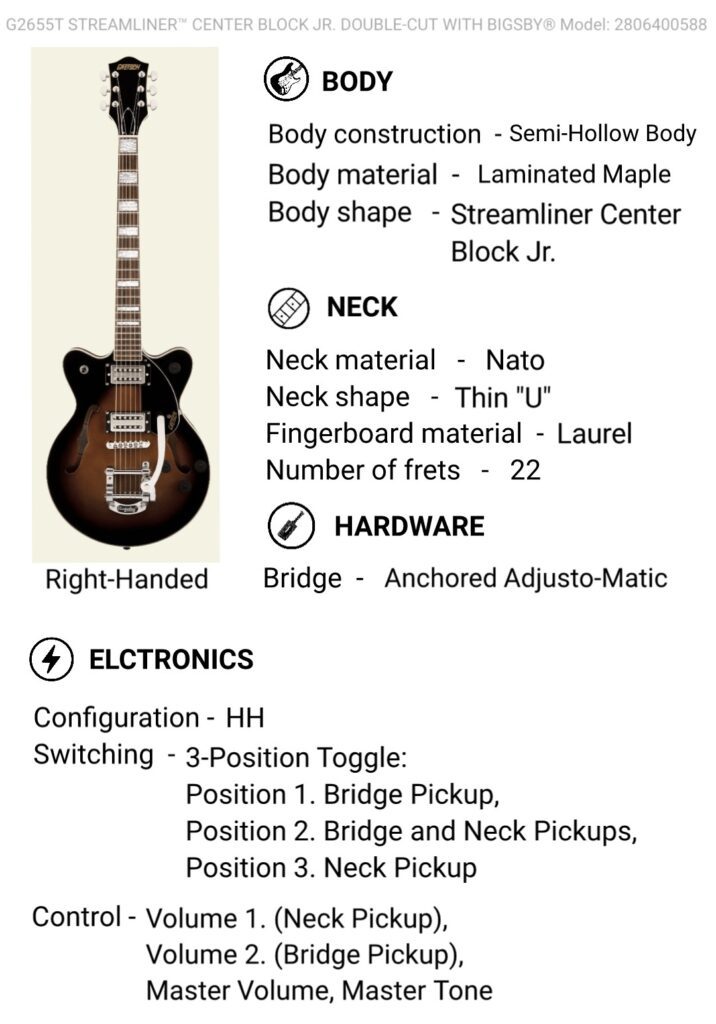
Read More
 Amazon.in
Amazon.in  ₹ 34,638
₹ 34,638  Go To Store
Go To Store
 Amazon.in
Amazon.in  ₹ 34,638
₹ 34,638  Go To Store
Go To Store
 Amazon.com
Amazon.com  $ 419
$ 419  Go To Store
Go To Store
 Amazon.com
Amazon.com  $ 419
$ 419  Go To Store
Go To Store
 Guitar Center
Guitar Center  $ 419
$ 419  Go To Store
Go To Store
 Thomann
Thomann  $ 498
$ 498  Go To Store
Go To Store
 Thomann
Thomann  $ 498
$ 498  Go To Store
Go To Store
Gretsch G5622T Electromatic Center Block Double-Cut With Bigsby
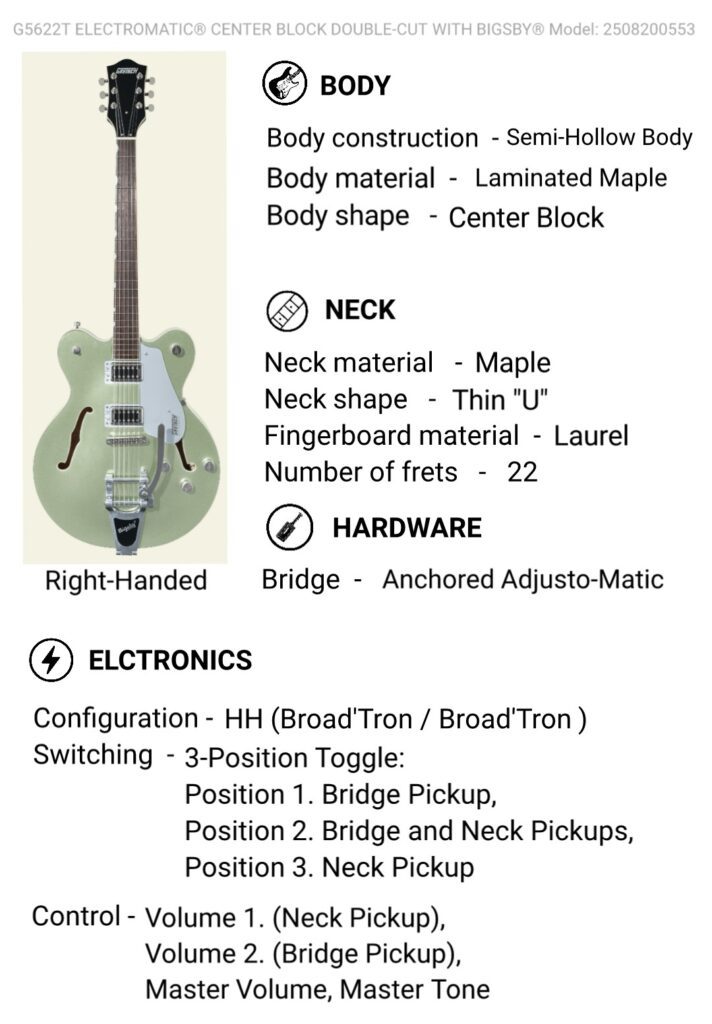
Read More
 Amazon.in
Amazon.in  ₹ 66,052
₹ 66,052  Go To Store
Go To Store
 Amazon.in
Amazon.in  ₹ 66,052
₹ 66,052  Go To Store
Go To Store
 Amazon.com
Amazon.com  $ 799
$ 799  Go To Store
Go To Store
 Amazon.com
Amazon.com  $ 799
$ 799  Go To Store
Go To Store
 Guitar Center
Guitar Center  $ 799
$ 799  Go To Store
Go To Store
 Thomann
Thomann  $ 744
$ 744  Go To Store
Go To Store
 Thomann
Thomann  $ 744
$ 744  Go To Store
Go To Store
Gretsch G2622T Streamliner Center Block Double-Cut With Bigsby

Read More
 Amazon.in
Amazon.in  ₹ 94,308
₹ 94,308  Go To Store
Go To Store
 Amazon.in
Amazon.in  ₹ 94,308
₹ 94,308  Go To Store
Go To Store
 Amazon.com
Amazon.com  $ 1140
$ 1140  Go To Store
Go To Store
 Amazon.com
Amazon.com  $ 1140
$ 1140  Go To Store
Go To Store
 Guitar Center
Guitar Center  $ 599
$ 599  Go To Store
Go To Store
 Thomann
Thomann  $ 499
$ 499  Go To Store
Go To Store
 Thomann
Thomann  $ 499
$ 499  Go To Store
Go To Store
Introduction: Semi-hollow body electric guitars feature a solid center block running through the body, with hollow wings on either side. This construction offers a balance between the warm, resonant tone of a hollow body guitar and the feedback resistance and sustain of a solid-body guitar.
”Read_More”
Evolution and Development: The concept of the semi-hollow body guitar emerged in the 1950s when guitar manufacturers sought to address the feedback issues associated with fully hollow instruments while retaining their desirable tonal qualities. One of the earliest and most iconic semi-hollow guitars is the Gibson ES-335, introduced in 1958. Its innovative design featured a solid maple block down the center, providing stability and reducing feedback while preserving the instrument’s acoustic-like tone.
Design and Construction: Semi-hollow body guitars typically have a top, back, and sides made of wood, with f-shaped sound holes on the upper bout. The solid center block, often made of maple, runs from the neck joint to the bridge, providing support and enhancing sustain. The hollow wings contribute to the guitar’s resonance and acoustic-like qualities.
Tonal Characteristics: The semi-hollow body design results in a unique sonic profile characterized by warmth, clarity, and a pronounced midrange. The combination of the solid center block and hollow wings produces a rich, resonant tone with enhanced sustain. Semi-hollow guitars excel in genres that demand dynamic range and articulation, such as jazz, blues, rockabilly, and alternative rock.
Versatility and Applications: Semi-hollow body guitars are prized for their versatility, capable of producing a wide range of tones suitable for various musical styles. Their balanced sonic character makes them ideal for both clean, melodic playing and overdriven, gritty tones. Guitarists appreciate their ability to cut through the mix in a band context while retaining warmth and clarity.
Popular Models and Players: In addition to the Gibson ES-335, several other manufacturers produce acclaimed semi-hollow body guitars. Models like the Epiphone Casino, Gretsch Streamliner, and PRS S2 Custom 22 have gained popularity among players of all levels. Renowned artists such as Chuck Berry, B.B. King, Eric Clapton, and Dave Grohl have all wielded semi-hollow guitars, contributing to their enduring appeal.
Conclusion: Semi-hollow body electric guitars offer a compelling blend of vintage aesthetics, tonal richness, and modern playability. Their versatile nature makes them suitable for a wide range of musical genres and playing styles, making them an essential tool in the arsenal of many guitarists seeking expressive and dynamic tones. Whether in the studio, on stage, or at home, semi-hollow guitars continue to captivate players with their timeless sound and character.
For which Genres of music is the Semi-hollow body electric guitars are suitable ?
Semi-hollow body electric guitars are suitable for a diverse range of musical genres due to their unique sonic characteristics and versatile playing capabilities. Here’s an explanation of the genres where semi-hollow body guitars excel:
- Blues: Semi-hollow body guitars are iconic in the blues genre, offering a warm, resonant tone with plenty of sustain. Their rich midrange and smooth overtones complement the expressive bends, slides, and vibrato techniques commonly used in blues playing. From Chicago blues to Texas blues, semi-hollow guitars have been favored by legendary artists like B.B. King, Albert King, and Freddie King.
- Jazz: Jazz guitarists appreciate the warm, rounded tone of semi-hollow body guitars, which pairs beautifully with clean, jazzy chord voicings and smooth, legato lines. The combination of the guitar’s hollow wings and solid center block enhances articulation and sustain, making it ideal for intricate jazz phrasing and chord melodies. Players like Wes Montgomery and George Benson have famously used semi-hollow guitars to shape the jazz landscape.
- Rockabilly and Rock ‘n’ Roll: Semi-hollow body guitars have a rich history in early rock ‘n’ roll and rockabilly music. Their twangy, yet full-bodied tone cuts through the mix, providing the perfect accompaniment to slapback rhythms and blistering solos. The resonance of semi-hollow guitars adds depth to the driving rhythms and lively leads characteristic of these genres. Artists like Eddie Cochran, Scotty Moore, and Brian Setzer have popularized semi-hollow guitars in the rockabilly and rock ‘n’ roll scenes.
- Alternative and Indie Rock: In alternative and indie rock music, semi-hollow body guitars offer a balanced blend of warmth, clarity, and sustain. Their versatile tonal palette makes them suitable for both clean, melodic passages and crunchy, overdriven riffs. Semi-hollow guitars excel in creating atmospheric textures and dynamic soundscapes, enhancing the sonic landscape of alternative and indie rock bands. Bands like Radiohead, Arctic Monkeys, and The War on Drugs have incorporated semi-hollow guitars into their signature sounds.
- Country and Americana: Semi-hollow body guitars have found a place in country and Americana music, providing a rich, twangy tone that complements the genre’s rootsy, storytelling style. Whether playing chicken-pickin’ licks, honky-tonk rhythms, or lush pedal steel-inspired swells, semi-hollow guitars deliver the expressive, dynamic response that defines country and Americana music. Artists like Chet Atkins, Brad Paisley, and Jason Isbell have utilized semi-hollow guitars to craft their distinct country sounds.
Overall, the versatile nature of semi-hollow body electric guitars makes them suitable for a wide range of musical genres, from traditional blues and jazz to modern rock, indie, and beyond. Their warm, resonant tone, enhanced sustain, and dynamic response continue to captivate players across various musical styles, making them an essential tool for expressive and emotive playing.
How to choose right Semi-hollow body electric Guitar
Choosing the right semi-hollow body electric guitar involves considering several factors to ensure it meets your playing style, preferences, and musical needs. Here’s a guide to help you make an informed decision:
- Tonal Preference: Consider the type of tone you prefer. Semi-hollow guitars offer a blend of the warmth and resonance of hollow body guitars with the sustain and feedback resistance of solid-body guitars. Determine if you prefer a brighter, more articulate sound or a warmer, fuller tone.
- Body Size and Weight: Pay attention to the size and weight of the guitar, especially if you plan to play long gigs or practice sessions. Semi-hollow guitars are lighter than solid-body guitars but heavier than hollow body guitars. Ensure the guitar feels comfortable to hold and play for extended periods.
- Construction and Materials: Evaluate the construction quality and materials used in the guitar’s body, neck, and hardware. High-quality woods, such as maple, mahogany, and spruce, contribute to the guitar’s tone and resonance. Look for well-constructed joints, smooth fretwork, and reliable hardware for optimal playability and durability.
- Pickup Configuration: Decide on the pickup configuration based on your playing style and tonal preferences. Semi-hollow guitars often come with a variety of pickup options, including P-90s, single-coils, humbuckers, or a combination of these. Experiment with different pickups to find the one that best suits your musical needs.
- Playability: Test the guitar’s playability by checking factors such as the neck profile, fretboard radius, and string action. Determine if the neck feels comfortable in your hand and if the fretboard radius suits your playing style. Ensure the string action is set to your liking and that the guitar is easy to play across the entire fretboard.
- Versatility: Consider the versatility of the guitar and its ability to cover a wide range of musical genres. Look for features such as coil-splitting or coil-tapping options, which allow you to switch between single-coil and humbucking tones, offering increased sonic flexibility.
- Aesthetics: Take into account the guitar’s aesthetic appeal, including its finish, hardware color, and overall design. Choose a guitar that resonates with your personal style and preferences, as you’ll likely be spending a lot of time playing and performing with it.
- Budget: Set a budget based on your financial constraints and stick to it while exploring available options. Keep in mind that higher-priced guitars often offer better build quality, components, and playability, but there are also excellent semi-hollow guitars available at more affordable price points.
By considering these factors and taking the time to play and compare different models, you can choose the right semi-hollow body electric guitar that suits your playing style, preferences, and budget.
Pros and Cons of Semi-hollow body electric Guitars
Pros:
- Rich Tone: Semi-hollow guitars offer a warm, resonant tone with natural acoustic qualities, making them suitable for a wide range of musical styles, including jazz, blues, rock, and more.
- Reduced Feedback: The center block in semi-hollow guitars helps to reduce unwanted feedback, especially at high volumes, making them ideal for live performances and recording situations.
- Versatility: Semi-hollow guitars often feature a variety of pickup configurations, including single-coils, humbuckers, or a combination of both, providing players with versatile tonal options to suit different musical genres and playing styles.
- Lightweight: Compared to solid-body guitars, semi-hollow guitars are generally lighter in weight, making them more comfortable to play for extended periods, whether standing or sitting.
- Acoustic Resonance: The hollow chambers in semi-hollow guitars contribute to their natural resonance and sustain, adding depth and character to the overall tone.
- Aesthetic Appeal: Many players are drawn to the classic and stylish appearance of semi-hollow guitars, which often feature f-holes and elegant designs that evoke a vintage vibe.
Cons:
- Prone to Feedback: While semi-hollow guitars are less susceptible to feedback than hollow body guitars, they can still be prone to feedback at high volumes or when positioned too close to amplifiers.
- Limited Sustain: Compared to solid-body guitars, semi-hollow guitars may have slightly reduced sustain due to their hollow or semi-hollow construction.
- Balance Issues: Some players may find that semi-hollow guitars have balance issues, particularly if the body is not properly weighted or if the guitar is neck-heavy.
- Vulnerable to Feedback: While the center block helps reduce feedback, semi-hollow guitars are still more vulnerable to feedback than solid-body guitars, particularly at high volumes or when using high-gain distortion.
- Less Resonance than Hollow Bodies: While semi-hollow guitars offer some acoustic resonance, they generally have less resonance and acoustic projection than fully hollow body guitars.
- Tone Variation: The tone of semi-hollow guitars can vary depending on factors such as body size, construction, and pickup configuration, so it’s essential to find a guitar that matches your tonal preferences.
Overall, semi-hollow body electric guitars offer a unique blend of acoustic warmth, resonance, and versatility, making them an attractive option for players seeking a guitar with character and charm. However, they may not be suitable for players who require high-gain distortion or maximum sustain in their playing style.
Hollow body Vs Semi-hollow body electric guitars
Hollow body and semi-hollow body electric guitars are two distinct types of instruments, each with its own unique characteristics and advantages. Here’s a comparison of the two:
Hollow Body Electric Guitars:
- Fully Hollow Construction: Hollow body guitars have a completely hollow body, with no solid center block. This design maximizes acoustic resonance, resulting in a rich, warm tone with excellent sustain.
- Larger Body Size: Hollow body guitars typically have larger bodies compared to semi-hollow guitars, which can contribute to their full, robust sound.
- Greater Susceptibility to Feedback: Due to their fully hollow construction, hollow body guitars are more prone to feedback, especially at higher volumes or when used with high-gain amplification.
- Ideal for Jazz and Blues: The warm, mellow tone of hollow body guitars makes them well-suited for jazz, blues, and other genres that require smooth, articulate playing.
- Vintage Aesthetic: Many hollow body guitars feature classic designs and aesthetic elements, such as f-holes and elegant finishes, which evoke a vintage vibe.
Semi-Hollow Body Electric Guitars:
- Semi-Hollow Construction: Semi-hollow guitars feature a combination of hollow and solid body elements, with a solid center block running through the body. This design reduces feedback while still providing some acoustic resonance.
- Versatility: Semi-hollow guitars offer a balance between the warm, resonant tone of hollow body guitars and the reduced feedback of solid-body guitars. They’re versatile instruments suitable for a wide range of musical styles, from jazz and blues to rock, indie, and beyond.
- Reduced Feedback: The presence of a solid center block helps to minimize feedback issues, making semi-hollow guitars more suitable for higher-volume playing and live performances.
- Comfortable Playability: Semi-hollow guitars are often lighter and more comfortable to play than fully hollow instruments, thanks to their reduced weight and ergonomic design.
- Wider Range of Tonal Options: Many semi-hollow guitars come equipped with multiple pickups and tone controls, offering players a broader range of tonal possibilities to explore.
In summary, the choice between hollow body and semi-hollow body electric guitars ultimately comes down to personal preference and the specific requirements of the player. Hollow body guitars excel in producing warm, resonant tones ideal for jazz and blues, while semi-hollow guitars offer greater versatility and reduced feedback, making them suitable for a wider range of musical genres and playing styles.
History of Semi-Hollow Body electric Guitars
The history of semi-hollow body electric guitars dates back to the mid-20th century when guitar manufacturers sought to combine the acoustic qualities of hollow body guitars with the reduced feedback of solid-body designs. Here’s a brief overview of the evolution of semi-hollow body guitars:
- Early Innovations: In the late 1940s and early 1950s, companies like Gibson and Gretsch experimented with semi-hollow designs, introducing models such as the Gibson ES-335 and the Gretsch 6120. These guitars featured a solid center block running through the body, with hollow wings on either side.
- Popularity in Jazz and Blues: Semi-hollow body guitars gained popularity among jazz and blues musicians for their warm, resonant tone and reduced feedback compared to fully hollow instruments. Players like B.B. King and Chuck Berry helped popularize these guitars in the 1950s and 1960s.
- Versatility in Rock Music: As rock music emerged as a dominant genre in the 1960s, semi-hollow body guitars found favor among rock guitarists seeking a versatile instrument capable of producing both smooth, mellow tones and gritty overdriven sounds. Artists like Eric Clapton and Dave Grohl have used semi-hollow guitars in their performances.
- Modern Innovations: In recent decades, guitar manufacturers have continued to innovate and refine semi-hollow body designs. They’ve introduced new features such as chambered bodies, thinner profiles, and improved electronics to enhance tone and playability.
- Continued Popularity: Today, semi-hollow body guitars remain popular among a wide range of musicians across various genres, from jazz and blues to rock, indie, and alternative music. They offer a unique blend of acoustic warmth, electric punch, and versatility, making them a favorite choice for many players.
Overall, the history of semi-hollow body electric guitars reflects a continuous quest for the perfect balance between acoustic resonance and electric performance, resulting in instruments beloved by musicians around the world.
”Read_Less”

